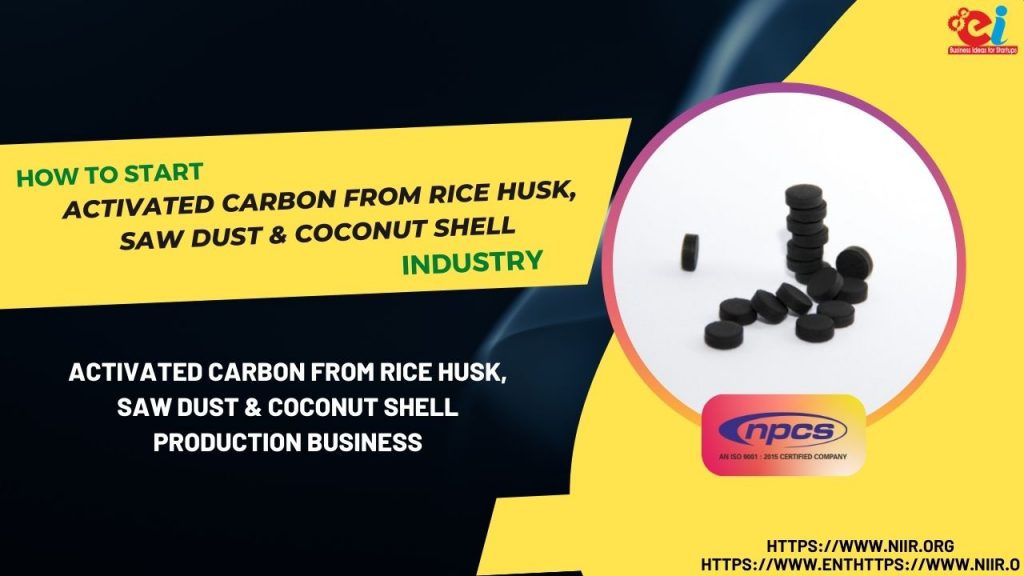An organic material with a large surface area is activated carbon. Typically, it is made from sawdust, bamboo, and coconut shell. The treatment of drinking water, wastewater, and air pollution can all benefit from the activated carbon’s ability to absorb pollutants in water. Additionally, it eliminates offensive tastes and odours from the food business.
Visit this Page for More Information: Start a Business in Activated Carbon Industry
Uses and Applications:
A porous substance with a lot of surface area, activated carbon may absorb gases and volatile substances. The variety of target molecules that activated carbon products adsorb or react with, as well as their possible applications, are varied.
Filters made of activated carbon are used to purify the air by capturing pollutants such dust, smoke, bacteria, and chemical vapours. Because activated charcoal absorbs radioactive materials, it is utilized to make clothing that protects against radiation exposure.
Related Business Plan: Set Up Activated Carbon From Rice Husk, Saw Dust & Coconut Shell Manufacturing Business Plan
Manufacturing Process:
There are four distinct stages to the production of activated carbon. The first step involves pyrolyzing coconut shell and sawdust to produce activated carbon. At this point, char particles are created by heating the raw materials to 400 degrees Celsius in a sealed container. The second stage, which takes about an hour, involves turning the char particles into activated carbon using steam at 900 degrees Celsius and pressures of 2-3 bars. Until all of the raw material is transformed, char particles are continuously fed into the reactor.
Download PDF: Start Activated Carbon from Rice Husk Saw Dust and Coconut Shell Processing Business
In the third stage, filter cloths are used to separate the created activated carbon from water (brine). It is then dried in hot air furnaces in preparation for future adsorbent use. The creation of activated carbon using sandalwood powder and rice husk similar steps but yields a smaller amount of the finished product.
Read Similar Articles: ACTIVATED CARBON
Benefits of Starting Activated Carbon from Rice Husk, Saw Dust & Coconut Shell Manufacturing Business:
– Starting a firm that produces activated carbon from rice husks, sawdust, and coconut shells has many advantages. There are lots of prospects for business owners who want to produce these items because of the rising demand for them in the cosmetics industry and because of global warming.
– Since the market is expanding, new business owners who are unfamiliar with the industry might fare better. It is simple to establish a modest manufacturing facility. Because they can use their leftover materials, like sawdust, rice husks, etc. to make money, many people are also interested in launching this business.
– Since there aren’t many expenses related to labour or raw materials, starting this kind of business requires little capital.
Market Size in India:
The future of the coconut shell, sawdust, and rice husk activated carbon markets in India looks bright. Coal-based facilities contribute for 48% of India’s total consumption, while gas-based facilities account for 33%.
Has grown in popularity recently due to its capacity to filter out environmental pollutants like mercury and arsenic that coal-based power plants leak into the environment. The price to buy it is expensive, though.
Related Feasibility Study Reports: Manufacturing Business Plan for Activated Carbon from Rice Husk, Saw Dust & Coconut Shell
Global Market Outlook:
Due to the growing demand for an eco-friendly replacement for plastics, the outlook for the global market for activated carbon made from rice husk, sawdust, and coconut shell is favourable.
Read our Books Here: The Complete Book on Biomass Based Products (Biochemicals, Biofuels, Activated Carbon)
Over the next five years, it is expected that this $14 billion business would expand by 20%. At a CAGR of 5.6% over the projected period, it is expected that the global market for activated carbon would increase from $4.98 billion in 2022 to $7.73 billion in 2030. Due to the significant demand for the product from numerous end-use sectors, including water treatment and air & gas purification, activated carbon is the market category with the quickest growth.
FAQ:
Q: Why should startups invest in Activated Carbon Manufacturing from Rice Husk, Saw Dust, & Coconut Shell, and what are the opportunities in this sector?
Answer:
Choosing to invest in the production of activated carbon from rice husk, saw dust, and coconut shell is a strategic and sustainable business decision for startups for several reasons. Firstly, these materials are abundant and renewable resources, ensuring a steady and sustainable supply chain.
Activated carbon is experiencing escalating demand globally due to its versatile applications in various industries like water treatment, air purification, food & beverage, and pharmaceuticals. The global activated carbon market is predicted to witness significant growth, with increasing awareness regarding water purification and waste management driving the market expansion.
This sector presents multifaceted opportunities due to the evolving environmental regulations and increasing demand for eco-friendly products, which necessitate the utilization of green and sustainable materials like rice husk, saw dust, and coconut shell. Moreover, advancements in technology and R&D in this field are constantly unveiling new applications for activated carbon, broadening the market scope.
Entering this industry allows startups to align with the trends of environmental sustainability and resource efficiency, while also capitalizing on the substantial market prospects presented by the activated carbon industry. The convergence of market growth, sustainability, and diverse application range makes the activated carbon manufacturing industry a lucrative venture for startups.
Click here to send your queries/Contact Us
See More Links:
- Start a Business in Asia
- Start a Business in Potential Countries for Doing Business
- Best Industry for Doing Business
- Business Ideas with Low, Medium & High Investment
- Looking for Most Demandable Business Ideas for Startups
- Startup Consulting Services
- Start a Business in Africa
- Start a Business in India
- Start a Business in Middle East
- Related Videos
- Related Books
- Related Projects
- Related Market Research Reports

